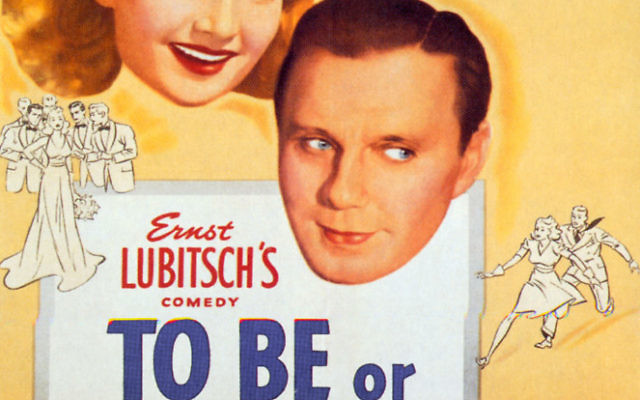AJFF: Nazis Spared Hollywood’s Pre-War Slings, Arrows
By Bob Bahr
“To Be or Not to Be,” the 1942 Jack Benny film that gets a retrospective showing Feb. 5 as part of the Atlanta Jewish Film Festival, is a reminder of Hollywood’s uncertain and sometimes controversial approach to Nazi Germany in the years leading up to World War II.

Directed by Ernst Lubitsch
“To Be or Not to Be” opened in March 1942, by which time Germany and the United States were at war.
The film, which premiered just four months after America entered the war, is a satirical sendup by the great German-born director Ernst Lubitsch of the Nazi occupation of Warsaw.
But humorous and not-so-humorous jabs at the Nazis in the years before World War II were surprisingly rare in Hollywood. Even though almost all the major studios were founded and run by Jews, some of whom had relatives in Europe who were being menaced by the wave of anti-Semitism unleashed by Hitler’s government, studio moguls were reluctant to confront the Nazis.
In his hard-hitting 2013 book “The Collaboration: Hollywood’s Pact With Hitler,” historian Ben Urwand goes so far as to suggest that the studios were intentionally soft on the Nazis. He describes how the Nazi government’s diplomatic consul in Los Angeles, Georg Gyssling, used his influence with the studios to shape and at times scuttle films that were critical of the Hitler regime.
Gyssling repeatedly invoked the possibility that American films would be banned in Germany for violating an obscure section of German law warning that if a studio distributed an anti-German film anywhere in the world, including in the United States, the studio would have all its films banned in the German market and any other countries the Nazis controlled.
To avoid such a strong hit to their bottom line, Urwand writes, the studios “collaborated” with the Germans — a word (Zussammenarbeit) the German consul used repeatedly in his diplomatic dispatches to Berlin.
With the exception of Warner Bros., the major studios with offices in Germany — Paramount, Universal and MGM — knuckled under. MGM notably canceled an adaptation of Sinclair Lewis’s 1935 novel, “It Can’t Happen Here,” about a fictional takeover of America by a fascist government.
Not only were some films suppressed or edited to meet German objections, but the number of Jewish characters appearing on screen declined sharply during the 1930s. Some of the ones who did appear, as in Twentieth Century Fox’s 1934 film The Rothschilds, played up anti-Semitic images of Jews as unscrupulous international moneylenders.

By Ben Urwand
Harvard University Press, 336 pages, $26.95
Images from that 1934 film even made their way into the Nazis’ infamous anti-Semitic pseudo-documentary in 1940, “The Eternal Jew.”
Urwand’s conclusions, particularly those that point to direct collaboration between the studios and the Nazi government, have been sharply attacked in the years since their publication.
In the just-published “From Shtetl to Stardom — Jews and Hollywood,” the noted Holocaust scholar and film writer Lawrence Baron revisits the controversy to accuse Urwand of “tunnel vision.”
While he doesn’t deny that Hollywood often deferred to German pressure in the pre-war years, Baron maintains that the studios were just one part of a complex web of relationships that kept the studios from taking a stronger stand against the rise of Hitler’s Germany.
He cites a concerted effort by the administrators of the studios’ mandatory but independent Production Code Office, the failure of Jewish organizations to take stronger action and the American government’s own policy of diplomatic neutrality toward the Nazi government as important factors in the studios’ tepid stand against fascism.
In the end, the strongest statement about Hitler’s rise to power in Europe came not from the major studios, but from the great film comedian Charlie Chaplin, who chose as his first sound film “The Great Dictator,” which began preproduction in 1938. Chaplin made the film, as he did all his productions, with his own money and with little care for what official Hollywood thought.
Although most of the Hollywood studio chiefs tried to talk him out of the project, he went ahead with the production when President Franklin Roosevelt sent a personal representative to guarantee that there would be no roadblocks as the Hitler-mocking production moved forward.

Edited by Michael Renov and Vincent Brook
Purdue University Press, 160 pages, $25
It turned out to be the most financially successful film of Chaplin’s long and illustrious career, and it played a crucial part on its release in 1940 in helping sustain the British during the withering German attacks from the air during the Blitz.
By the time Jack Benny’s “To Be or Not to Be” hit theaters, Hollywood was in full retreat from its policy of appeasement of Germany. America was in the early stages of a world war in which European Jewry was nearly destroyed and an estimated 55 million people died — proof, if any had been needed, of just how costly that conciliatory policy had been.
Bob Bahr and Matthew Bernstein will present their “Best Bets of the Atlanta Jewish Film Fest” on Sunday, Jan. 15, at 2 p.m. at Temple Sinai in Sandy Springs and at 6 p.m. at The Temple in Midtown. Bob Bahr will present the “Best Bets” program at Temple Emanu-El in Sandy Springs on Thursday, Jan. 19, at 7 p.m.




comments